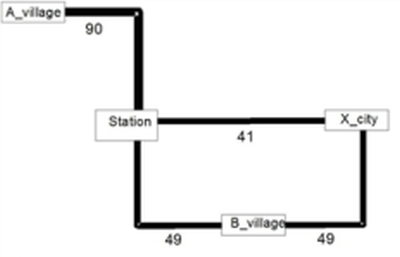The effect of the connection choice for the timetable-based method is shown with the results of the connection search regarding a 10-minute transfer penalty. The branch & bound search is used. This search returns the five connections shown in Table 192. A monocriterion shortest path search however would only find the connections 1, 3 and 5, as they have the lowest impedance of all the connections of their departure times. The impedance (= perceived journey time) results from the weighted sum of the following skims: journey time (JRT), transfer wait time (TWT) and number of transfers (NTR).
The Table 193 shows the impedances of the connections. As ∆T depends on the desired departure time of the passengers, different impedance values result for the various time slices of travel demand. Thus, the impedances of the first two connections are lower in the first interval, whereas those of the last three connections are lower in the second interval. The impedance definition is set in such a way, that the following applies:
Ria = PJTi • 1.0 + ∆Tiaearly • 1.0 + ∆Tialate • 1.0
Then, a distribution rule (here Kirchhoff with β = 3) is used to calculate the shares Pia which are allocated to the individual connections. The independence is ignored in this formula. As shown in Table 194, all five connections are assigned non-zero percentages of the travel demand per time interval.
This results in the volumes shown in Illustration 165.

Illustration 165: Network volume for timetable-based assignment

